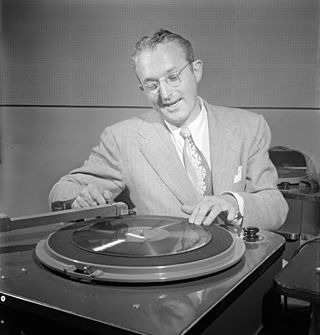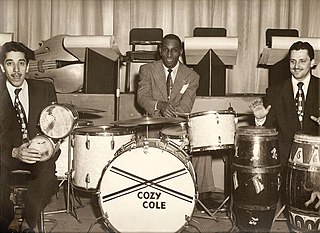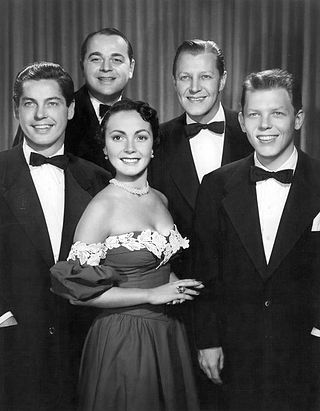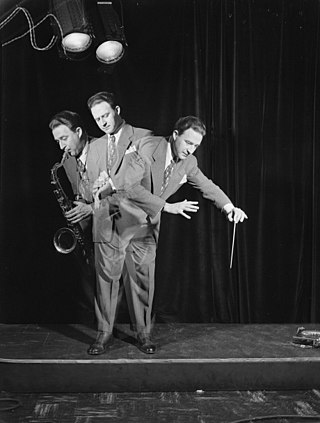
Lester Raymond Brown was an American jazz musician who led the big band Les Brown and His Band of Renown for nearly seven decades from 1938 to 2000.
Swing music is a style of jazz that developed in the United States during the late 1920s and early 1930s. It became nationally popular from the mid-1930s. The name derived from its emphasis on the off-beat, or nominally weaker beat. Swing bands usually featured soloists who would improvise on the melody over the arrangement. The danceable swing style of big bands and bandleaders such as Benny Goodman was the dominant form of American popular music from 1935 to 1946, known as the swing era. The verb "to swing" is also used as a term of praise for playing that has a strong groove or drive. Musicians of the swing era include Duke Ellington, Benny Goodman, Count Basie, Cab Calloway, Jimmy Dorsey, Tommy Dorsey, Woody Herman, Harry James, Lionel Hampton, Glenn Miller, Artie Shaw and Django Reinhardt.

Ernest Loring "Red" Nichols was an American jazz cornetist, composer, and jazz bandleader.

Thomas Francis Dorsey Jr. was an American jazz trombonist, composer, conductor and bandleader of the big band era. He was known as the "Sentimental Gentleman of Swing" because of his smooth-toned trombone playing. His theme song was "I'm Getting Sentimental Over You". His technical skill on the trombone gave him renown among other musicians. He was the younger brother of bandleader Jimmy Dorsey. After Dorsey broke with his brother in the mid-1930s, he led an extremely successful band from the late 1930s into the 1950s. He is best remembered for standards such as "Opus One", "Song of India", "Marie", "On Treasure Island", and his biggest hit single, "I'll Never Smile Again".

William Clarence Eckstine was an American jazz and pop singer and a bandleader during the swing and bebop eras. He was noted for his rich, almost operatic bass-baritone voice. In 2019, Eckstine was posthumously awarded the Grammy Lifetime Achievement Award "for performers who, during their lifetimes, have made creative contributions of outstanding artistic significance to the field of recording." His recording of "I Apologize" was given the Grammy Hall of Fame Award in 1999. The New York Times described him as an "influential band leader" whose "suave bass-baritone" and "full-throated, sugary approach to popular songs inspired singers like Earl Coleman, Johnny Hartman, Joe Williams, Arthur Prysock, and Lou Rawls."

Lucius Venable "Lucky" Millinder was an American swing and rhythm-and-blues bandleader. Although he could not read or write music, did not play an instrument and rarely sang, his showmanship and musical taste made his bands successful. His group was said to have been the greatest big band to play rhythm and blues, and gave work to a number of musicians who later became influential at the dawn of the rock and roll era. He was inducted into the Alabama Jazz Hall of Fame in 1986.

Ben Pollack was an American drummer and bandleader from the mid-1920s through the swing era. His eye for talent led him to employ musicians such as Benny Goodman, Jack Teagarden, Glenn Miller, Jimmy McPartland, and Harry James. This ability earned him the nickname the "Father of Swing".

The Mills Blue Rhythm Band was an American big band active during the 1930s.

Sammy Kaye was an American bandleader and songwriter, whose tag line, "Swing and Sway with Sammy Kaye", became one of the most famous of the Big Band Era. The expression springs from his first hit single in 1937, "Swing and Sway". His signature tune was "Harbor Lights", a number-one hit from late 1950.

Noble Lee Sissle was an American jazz composer, lyricist, bandleader, singer, and playwright, best known for the Broadway musical Shuffle Along (1921), and its hit song "I'm Just Wild About Harry".

Martha Tilton was an American popular singer during America's swing era and traditional pop period. She is best known for her 1939 recording of "And the Angels Sing" with Benny Goodman.

William Randolph "Cozy" Cole was an American jazz drummer who worked with Cab Calloway and Louis Armstrong among others and led his own groups.

Benjamin Anzelwitz, known professionally as Ben Bernie, was an American jazz violinist, bandleader, and radio personality, often introduced as "The Old Maestro". He was noted for his showmanship and memorable bits of snappy dialogue, being part of the first generation of "stars" of American popular music, alongside other artists such as Paul Whiteman, Ted Lewis and Al Jolson.

Paula Kelly was an American big band singer.

Jonah Jones was a jazz trumpeter who created concise versions of jazz and swing and jazz standards that appealed to a mass audience. In the jazz community, he is known for his work with Stuff Smith. He was sometimes referred to as "King Louis II", a reference to Louis Armstrong. Jones started playing alto saxophone at the age of 12 in the Booker T. Washington Community Center band in Louisville, Kentucky, before quickly transitioning to trumpet, where he excelled.

Teddy Hill was an American big band leader and the manager of Minton's Playhouse, a seminal jazz club in Harlem. He played a variety of instruments, including drums, clarinet, soprano and tenor saxophone.
Territory bands were dance bands that crisscrossed specific regions of the United States from the 1920s through the 1960s. Beginning in the 1920s, the bands typically had 8 to 12 musicians. These bands typically played one-nighters, six or seven nights a week at venues like VFW halls, Elks Lodges, Lions Clubs, hotel ballrooms, and the like. Francis Davis, jazz critic for The Village Voice, likened territory bands to "the Top 40 cover bands of their day, typically relying on stock arrangements of other ensembles' hits." He said, "many historians give much credit to territory bands for popularizing modern ballroom dancing that began during the World War I era with the influence of Vernon and Irene Castle."
William James Finegan was an American jazz bandleader, pianist, arranger, and composer. He was an arranger in the Glenn Miller Orchestra in the late 1930s and early 1940s.
Norris Turney was an American jazz flautist and saxophonist.

Jerry "Buck" Jerome was an American jazz and big band musician, a tenor saxophonist. He played with Glenn Miller, Red Norvo, Benny Goodman and Artie Shaw.
















